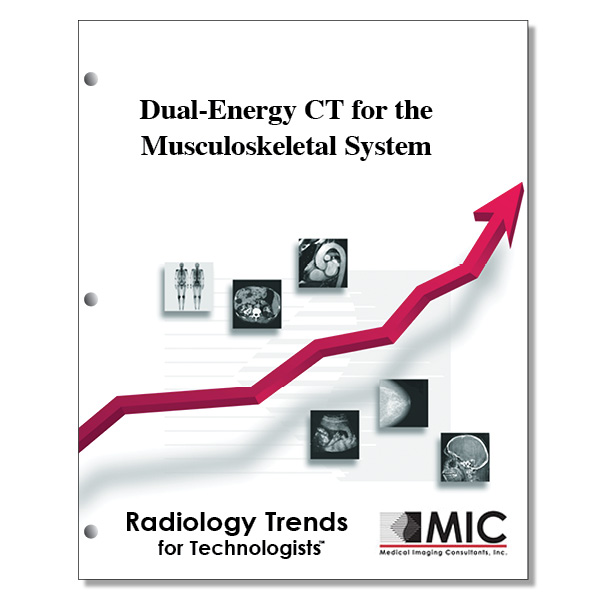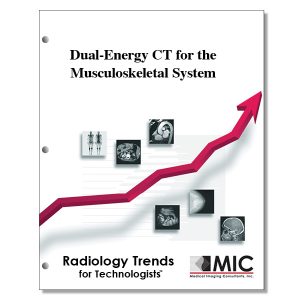

Dual-Energy CT for the Musculoskeletal System
A summary of the application of dual energy CT to musculoskeletal imaging, including basic principles, scanner designs, current clinical applications, and potential areas of development.
Course ID: Q00536 Category: Radiology Trends for Technologists Modality: CT3.5 |
Satisfaction Guarantee |
$37.00
- Targeted CE
- Outline
- Objectives
Targeted CE per ARRT’s Discipline, Category, and Subcategory classification for enrollments starting after March 18, 2024:
Computed Tomography: 3.50
Image Production: 3.50
Image Formation: 3.50
Outline
- Introduction
- Basic Principles of Dual-Energy CT
- Physics
- Hardware Design
- Postprocessing Tools
- Dose Considerations
- Time Considerations
- Clinical Applications
- Metal Artifact Reduction Techniques
- Gout Imaging-Urate Detection and Analysis
- Bone Marrow Edema Detection
- Collagen Analysis: Ligaments, Tendons, and Intervertebral Disks
- Bone Mineral Density Analysis
- Dual-Energy CT for Detection of Metastases
- Iodine Application in CT Arthrography
- Conclusion
Objectives
Upon completion of this course, students will:
- know the advantages of dual-energy CT over conventional CT
- be familiar with the term DEI
- know what the k-edge is
- understand the drawbacks of sequential scanning
- be familiar with sequential dual-energy CT scanning
- be familiar with double-layer detector dual-energy CT scanning
- be familiar with dual-source dual-energy CT scanning
- be familiar with rapid photon switching dual-energy CT scanning
- understand the material-specific display technique
- understand the energy-specific display technique
- be familiar with the dose of dual-energy CT scans compared to the dose of conventional CT scans
- describe the presentation of particle disease In patients with metallic prostheses
- describe the presentation of aseptic loosening In patients with metallic prostheses
- describe the presentation of periprosthetic fractures in patients with metallic prostheses
- know which imaging modality is considered the definitive test for suspected infection in patients with metallic prostheses
- understand how to reduce the appearance of metal artifacts on conventional polychromatic CT images
- know what the “sweet spot” is for implant images
- understand what the optimal extrapolated energy level depends on
- know what is currently considered the reference standard for the diagnosis of gout
- be familiar with the role of plain radiography for assessing patients with gout
- be familiar with the role of dual-energy CT for assessing patients with gout
- be familiar with the role of MR imaging for assessing patients with gout
- know the artifacts radiologists should recognize when using dual-energy CT gout protocols
- recall how bone marrow edema secondary to trauma has historically been diagnosed
- understand why conventional CT often provides suboptimal visualization of the bone marrow cavity
- be familiar with the limitations of dual-energy CT VNCa imaging of bone marrow lesions
- know what the visualization of collagenous structures with dual-energy CT is dependent on
- understand how conventional CT compares with dual-energy CT imaging of the hand
- understand the use of dual-energy CT images reconstructed in an oblique sagittal plane in patients with traumatic ACL disruption
- know which imaging modality is the reference standard for characterizing the collagen of intervertebral spinal disks
- know which imaging modality the WHO considers the reference standard for osteoporosis assessment and diagnosis
- be familiar with the limitations of DXA
- understand the changes in tissue composition that occur during the process of metastatic seeding and infiltration
- be familiar with the tissue composition of vertebral body metastases
- be familiar with the tissue composition of Schmorl nodes
- understand the enhancement patterns of sclerotic components of bone lesions when using contrast-enhanced CT imaging
- understand the enhancement patterns of lytic soft tissue components filled with tumor tissue when using contrast-enhanced CT imaging
- be familiar with the advantages of CT arthrography when compared with MR imaging
- understand the mechanisms by which dual-energy CT may enhance arthrographic images beyond those of conventional CT
- know what clinical outcomes may result as dual-energy CT technology advances
